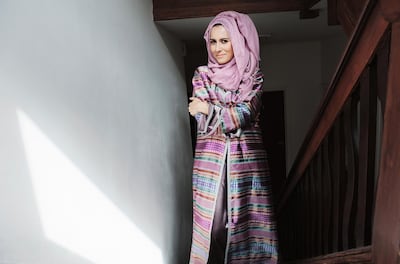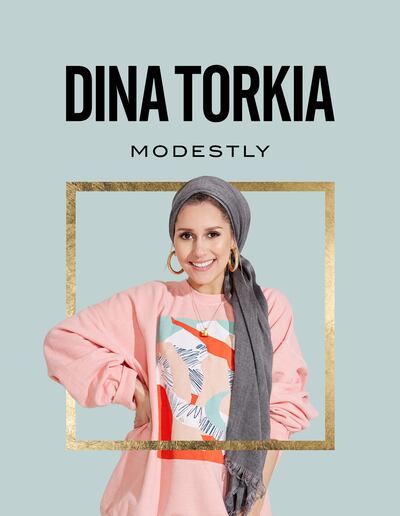"This is going to break the internet," reads one user's comment under an Instagram post by Ascia Al Faraj last Thursday. The post in question is not a pressing world issue or a meme worthy of going viral, but an image of the popular American-Kuwaiti fashion blogger dressed stylishly all in white, with her tattoos and curly hair visible.
Al Faraj, 29, is famous for being one of the fashion blogsphere's first hijab-wearing faces, and therein lies the apparent controversy: she has decided to stop covering her hair.
The image amassed 97,000 likes and 11,000 comments within five hours of being posted, with many supporting the blogger and cyberbullying spokesperson, and others attacking her decision to de-veil.
Infusing the hijab with positive connotations
Al Faraj was one of the region's early influencers to make it big internationally, becoming a front-row regular at European fashion weeks and a star of digital campaigns by luxury labels. She and the UK's British-Egyptian blogger Dina Torkia were the first to use social media to promote positive and stylish images of hijabs in a post-9/11 era.
Together, Al Faraj and Torkia influenced countless Muslim women, including Zahra Valji, founder of home decor brand Ayah Home, who was raised in the UK and was the only hijab-wearing student at her Essex school.
“It was so inspiring to see girls the same age as me paving the way for modest fashion with such confidence and style,” says Valji, who lives in Dubai. “It made me realise that wearing the hijab should not hold me back nor make me feel like I couldn’t do and be anything I wanted to.”
No longer identifying as 'hijabi'
Al Faraj may look like she's living the dream through globetrotting escapades with luxury labels and collaborations with Chanel, Aigner, Kenzo and more. But in the nine-minute video she posted to YouTube last week, the influencer opens up about how anxiety due to being in the public spotlight has severely affected her, and how she no longer feels like her identity now – 10 years after wearing the hijab – is congruent with her online image. So, to stay true to herself she says she will stop wearing the turban beanies and headwraps that have become her trademark.
A day before Al Faraj's Instagram post, British-Muslim fashion designer and BBC's The Apprentice star Bushra Shaikh, who has worn the hijab for 26 years, also decided to stop wearing it. She wrote an article for The Telegraph, explaining that for her, too, it was necessary that her inner faith be authentically represented by her public image. Incidentally, Torkia, too, decided to stop wearing the hijab full-time earlier this year.
While many Muslims believe that covering your hair is a mandatory requirement for women, others contest the obligatory nature of the headscarf. Religious debate aside, for some Muslim women, the garment makes a political or even feminist statement – it is a way to assert their faith and identity in societies that are prejudiced against Muslims, and often sexualise women and their bodies.
"My wearing of the hijab was like shouting out to the world: 'I am a Muslim and a proud one, too!' We were very much unapologetically Muslim back then," writes Torkia in her 2018 autobiography Modestly.
She and Al Faraj embarked on a plight to paint a picture of a modern Muslim woman who wasn't oppressed or drably dressed. Over time, they were unwittingly branded as ambassadors for Muslim women worldwide, answerable as role models to hoards of young girls.
Targeted by trolls
However, when they wore headscarves that revealed their necks or a few strands of hair, this went against the “rules of hijab”, according to some of their social media followers, many of whom would leave insulting comments under their posts.
When Torkia and Al Faraj stopped identifying as "hijabi" altogether, the negativity intensified, often from users who had followed their journeys from the beginning and felt let down by their decisions to "leave" the hijab-wearing community. Some called out the bloggers for being hypocritical, for abandoning the message that they had earned them their fame and money, and helped them brand themselves.
Al Faraj acknowledges this reality in last week’s YouTube video, even as she states: “Because I can no longer say that I identify with my headscarf, it’s time for me to take a step back from [the spotlight] and no longer take a spot in campaigns or other media.”
Fashion designer Safiya Abdallah, who lives in Dubai and chooses to wear a hijab, says: “It’s so irritating to read the incredibly rude and obnoxious comments here by people who feel holier-than-thou to judge someone who started her journey never asking to be the role model for all Muslims. I hope people find their own inner peace and stop bringing so much negativity to others lives.”
Valiji agrees: “I think the comments that some of their followers on social media give are awful, disrespectful and completely anti-feminist. We should be supporting each other, not trying to bring another woman down,” she says.
Modestwear on the rise
Hijab-wearing women have come a long way in the mainstream media. Today, they're part of campaigns for brands such as Fenty Beauty, shown on characters in television shows such as Tom Clancy's Jack Ryan, and are increasingly being included at major fashion weeks, thanks largely to model Halima Aden. The movement shows no sign of slowing its pace – just this month at London Fashion Week and Milan Fashion Week respectively, Burberry and Fendi enlisted Somali hijab-wearing model Ugbad Abdi for their shows.
The hijab is also finding a place in mainstream fashion magazines, reality shows and museum exhibitions, and the modest fashion blogging movement, pioneered by Al Faraj and Torkia, certainly helped fuel this newfound celebration of the headscarf.
“Never has there been a time where people have been confronted with the image of the modern Muslim woman so much – I think we’ve hit a new milestone. I think it has been accepted, it’s mainstream now,” says Sabrina Salhi, founder of ladies-only event concept Unveiled DXB. “I remember when Dina Torkia first started, and the whole social media scene was still beginning, just to see someone wearing the hijab on the platform was like wow, it was so new. But now with thousands of influencers, I think it has become normalised. Dina achieved what she set out to do – take the hijab and make it mainstream.”
When Torkia and Al Faraj rose to fame, they were fighting for space, respect and representation as visibly Muslim women. Now, both married mothers of two, their lifestyles, priorities, beliefs and appearances may have slightly changed (both still continue to dress modestly from the neck down), but the message they’ve championed all along is one and the same: that women’s decisions about covering (or not) are reflective of their own personal choices and identity.
As Al Faraj concludes in her testimony after unveiling: "Choosing to cover at 19 felt spiritually, mentally and physically correct. And now I'm 29 ... and as I've aged, I've grown so much. I've left so many silly ideas of other people and myself behind. The disconnect of my identity, how I truly feel, and the identity that I continue to portray online despite having outgrown it caused me so much sadness that I just wasn't being 100 per cent honest with who I was. And I would really like that not to be so anymore."



